|
Welcome to the final week of the Plastic-Free Challenge! This week we are going to cover the plastics involved in our personal care and cleaning routines as well as how to continue to be a leader after this challenge ends.
Today we’ll focus on personal care and cleaning. There are many ways to edit your routines to include fewer disposable products, avoid packaging, and use non-toxic ingredients to protect the health of your family.
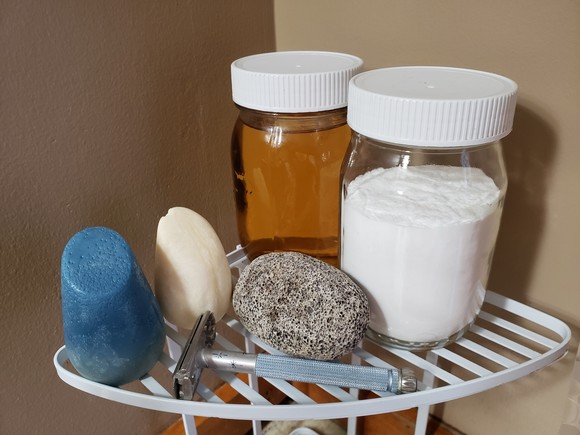 Create a plastic-free bathroom

Reduce your use of disposable plastic items in the bathroom. Look for reusable options for things such as facial wipes, cleaning wipes, razors, or menstrual products. These cannot be recycled and are a consistent source of plastic trash. Reusable items cost more up front, but can save money over time.
You could invest in items such as safety razors or menstrual cups slowly as your budget allows.
Simplify your hair care, skin care and makeup routines. Don’t let social media convince you a 47-step routine is essential! There are also a lot of kitchen products that can be used for multiple purposes, such as olive or coconut oils. For makeup, consider having one or two shades of products like eyeliner, eye shadow, or lipstick instead of many that you only use once or twice a year.
To reduce plastic packaging, check the stores you regularly visit for solid bar options for shampoo, conditioner, and body lotion, or learn how to make your own products, including scrubs, moisturizers, and even deodorant.
Don’t forget about buying in bulk! Bulk sections offer more than just food options. You can find many personal care products, too. Check your local co-op or zero waste store for refillable hair, skin, and cleaning products. The photo below is an example of the variety of items found at Tare Market.
|
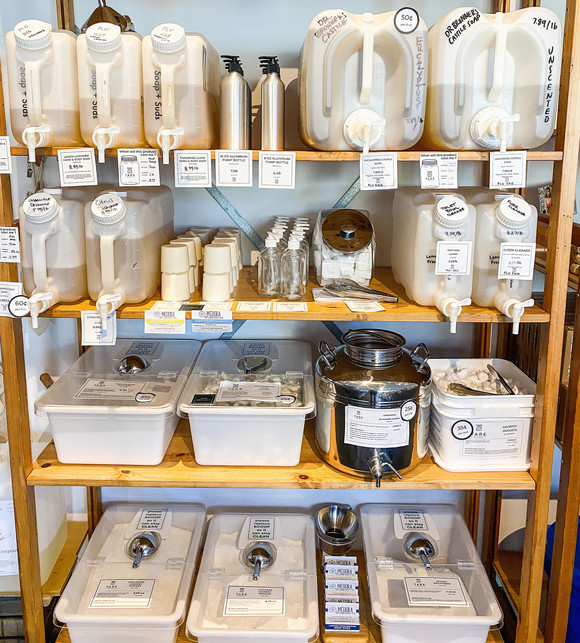 |
Photo credit: Tare Market
Use safe cleaning products
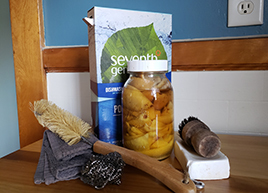
Understanding the safety of the cleaning products we use is important because they can impact both our health and the health of our kids and pets if they enter our bodies through our skin, mouth, or lungs.
See the Hennepin County’s reducing hazardous chemicals in your home and green cleaning recipes (PDF) to learn more about reading labels and choosing safer alternatives.
For a simple option, make your own cleaners with non-toxic ingredients. If you have vinegar, baking soda, dish soap, and a rag, you’re in great shape! Most jobs can be done with these ingredients. Download Hennepin County’s green cleaning recipe cards to get started.
|
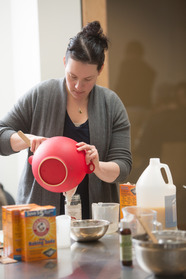
Reuse for less waste
Use your “reduce and reuse” mindset when it comes to cleaning ingredients and supplies. Reduce packaging by buying ingredients in the largest size package, from the bulk section, or in a solid bar or powder form. For example:
- Buy vinegar or baking soda in large containers.
- Refill your existing spray bottle with homemade cleaner and your hand soap dispenser with soap from a large refill container or from the bulk section.
- Reuse an old spice or parmesan container to sprinkle baking soda onto surfaces for scrubbing or deodorizing – be sure to label it.
- Save packaging by not buying water – choose laundry detergent, stain removers, toilet cleaners, dishwashing detergent, dish soap and more in bar or powder form
Ditch the disposable wipes, wands, and dusters in favor of reusable brushes, cloths, and scrubbers. Cut up old towels or t-shirts for wiping rags and use old toothbrushes for detailed scrubbing. Reuse old kitchen sponges for dirtier messes before tossing them out. If you already own cleaning equipment that uses disposable cloths, scrubbers or pads, look up hacks for how to use them with washable cloths instead.
|
Take action
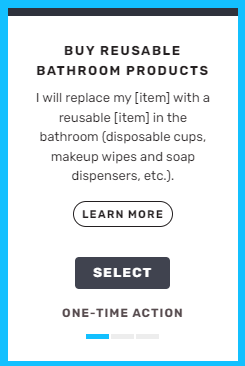
If you want to focus on creating a plastic-free bathroom, commit to actions in the personal care category:
- Purchase alternative toothpaste
- Switch to a plastic-free shave
- Have waste-free periods
- Choose plastic-free deodorant
- Use plastic-free beauty packaging
- Practice low-waste hair care
- Buy reusable bathroom products
|
Final days to report your actions
To keep yourself accountable and see the impacts add up for the work you have done, be sure to report your actions when you complete them. The challenge wraps up on Thursday, February 29, so remember to report the actions you’ve done by the end of the day!
Open up your dashboard and scroll down to see the actions you selected. Click the button to mark as complete.
Friday, February 2: Tips for getting started with the challenge
Monday, February 5: The problem with plastics
Wednesday, February 7: Types of plastics
Friday, February 9: Effectiveness of plastics recycling
Monday, February 12: Going plastic-free with your family
Wednesday, February 14: Reducing plastic in your wardrobe
Friday, February 16: Plastic-free pets, your other children
Monday, February 19: Changing how you shop
Wednesday, February 21: Avoiding plastics while dining out and on-the-go
Friday, February 23: Advocating for more plastic-free options
|